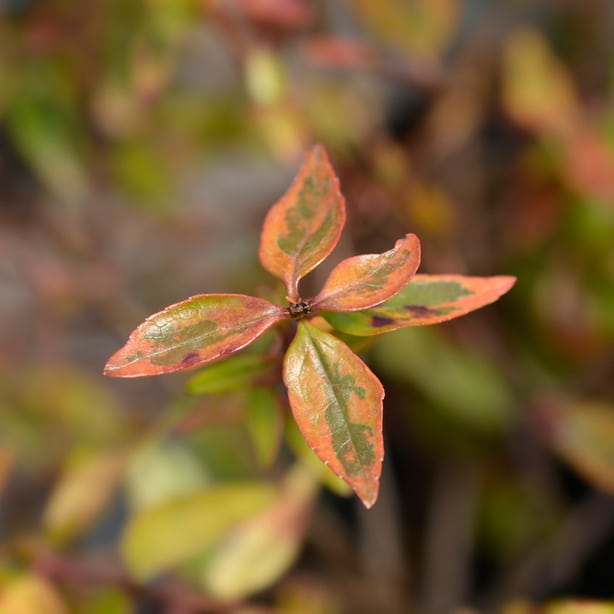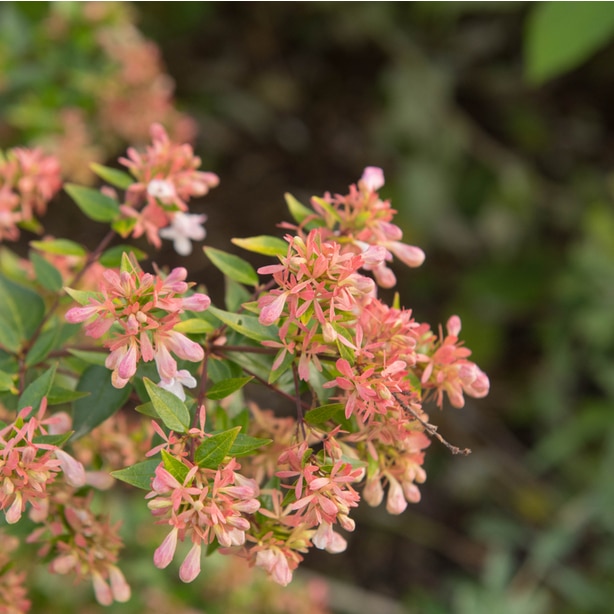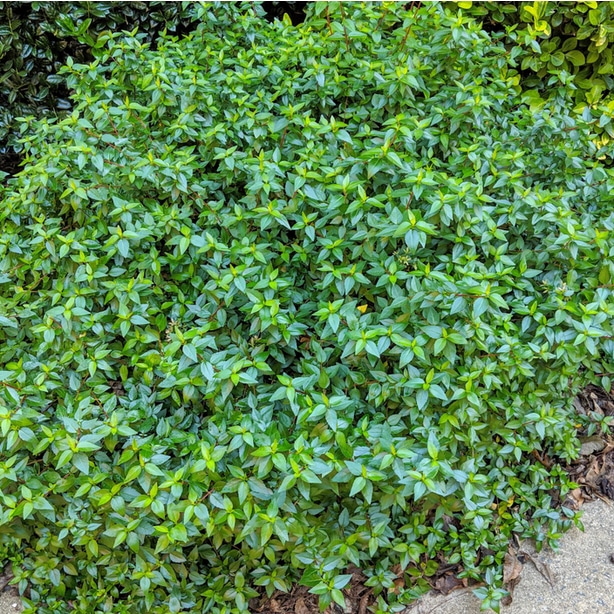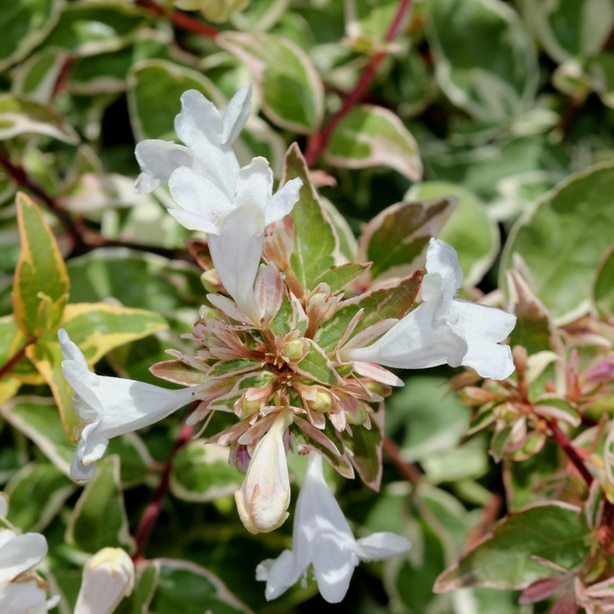If you’re looking for flowering shrubs for your southern landscape, you should consider planting abelias in your yard. Known as “tough but beautiful,” these easy-to-grow perennial plants offer stunning year-round interest to your yard — flowering from mid-spring to fall and holding onto brilliantly colored foliage all year in most areas they are grown.
Another popular tree to consider growing in your yard is the Japanese maple tree. Make sure to check out our guide on everything you need to know about raising the Japanese maple tree.
- Characteristics
- Why Grow Them
- 13 Types to Consider Growing
- Kaleidoscope (Abelia x grandiflora ‘Kaleidoscope’)
- Glossy Abelia (Abelia x grandiflora)
- Rose Creek (Abelia x chinensis ‘Rose Creek’)
- Sunshine Daydream (Abelia x grandiflora ‘Abelops’)
- Edward Goucher
- Confetti (Abelia x grandiflora ‘Confetti’)
- Little Richard (Abelia x grandiflora ‘Little Richard’)
- Mardi Gras (Abelia × grandiflora ‘Mardi Gras’)
- Radiance (Abelia x grandiflora ‘Radiance’)
- Sweet Emotion (Abelia mosanensis)
- Raspberry Profusion (Abelia x grandiflora ‘Raspberry Profusion’)
- Miss Lemon (Abelia x grandiflora ‘Hopleys’)
- Sunny Anniversary (Abelia x grandiflora ‘Minduo1’)

Characteristics
Abelias (Abelia spp) are semi-evergreen to evergreen shrubs in the honeysuckle family. These cottage garden plants lost popularity for some time but are becoming a favorite again with homeowners living in warmer climates. They are known for their tubular or bell-shaped blooms that last almost all season and their striking foliage color that changes as leaves mature.
Why Grow Them
First and foremost, abelias are revered by gardeners and homeowners for their long flowering ability and year-round interest. They bloom throughout most of the active growing season, with their flowers opening in spring and lasting until the first frost. Beyond that, they also have many other fantastic attributes that make them an excellent landscape plant.
- Rabbit and deer resistant.
- No serious pest or disease problems.
- Attract butterflies, bees, and hummingbirds to the garden.
- Don’t exhibit invasive properties.
- Very drought tolerant and hardy.
- Adaptable to a wide range of soil types and pH levels.
- Love full sun planting sites but tolerant of partial shade.
- Versatility in size makes them great as foundation plantings, shrubs, or a low hedge.
13 Types to Consider Growing
The many different types of abelias offer various shrub sizes, flower colors, and foliage colors, giving you many options to choose from. Here are some of the more common types and some of the more unique, interesting varieties. All of them would make a beautiful addition to your garden or yard.
Kaleidoscope (Abelia x grandiflora ‘Kaleidoscope’)
Growing Zones: 6 to 9
Plant Height: 2 to 3’
Flower Color: White
Leaf Color: Light green and yellow in spring to dark green and orangish-red in fall
Kaleidoscope abelia is one of the most popular types. This semi-evergreen shrub is one of the longest blooming types, and its chameleon-like foliage hangs on better through the winter than many others. White, subtly fragrant flowers erupt in late spring and last through fall. New leaves have light green centers surrounded by yellow and transition to darker green with reddish-orange leaf margins.

Glossy Abelia (Abelia x grandiflora)
Growing Zones: 6 to 9
Plant Height: 3 to 6’
Flower Color: White with a hint of pink
Leaf Color: Dark green glossy
Known for its beautiful glossy foliage, Glossy abelia is semi-evergreen to evergreen, depending upon the climate. Adaptable to a wind range of soil types and pH levels, the glossy green leaves on the arching branches turn purplish bronze in the fall. Slightly fragrant pastel flowers bloom on new growth in late spring, so prune shrubs in late winter or early spring.

Rose Creek (Abelia x chinensis ‘Rose Creek’)
Growing Zones: 6 to 9
Plant Height: 4’
Flower Color: White
Leaf Color: Glossy green in spring, shades of bronze or burgundy in fall
Another evergreen type, Rose Creek, is the rosiest on the list. New leaves have a pinkish cast and form on crimson stems. The leaves mature to darker green in the summer and take on a purple hue in the winter. Clusters of showy, fragrant white flowers bloom from pink sepals. Rose Creek abelia likes the soil to dry out slightly before watering.
Sunshine Daydream (Abelia x grandiflora ‘Abelops’)
Growing Zones: 6 to 9
Plant Height: 3 to 4’
Flower Color: White
Leaf Color: Golden yellowish and green with hints of pink
Sunshine Daydream is noted for its striking, tricolor evergreen foliage. Leaves emerge as dark pink with green and white variegation and soften to dreamy pink, golden yellow, and green. With slightly fragrant white flowers, it is an elegant mixture of color and texture. With a moderate growth rate, Sunshine Daydream can live up to 30 years.

Edward Goucher
Growing Zones: 6 to 9
Plant Height: 3 to 5’
Flower Color: Lilac-pink
Leaf Color: Dark green tinged with bronze
Introduced in 1911 by Edward Goucher of the US Department of Agriculture, Edward Goucher abelia is a compact shrub with lavender flowers with orange speckles on the throat. Its glossy deep green foliage takes on a bronze-purple hue as it matures. An Award of Garden Merit recipient (Royal Horticultural Society), it is adaptable but prefers fertile, well-drained, full sun planting spots.
Confetti (Abelia x grandiflora ‘Confetti’)
Growing Zones: 6 to 9
Plant Height: 2 to 3’
Flower Color: White
Leaf Color: Light green with creamy white margins, with rosy hue in fall
Another compact beauty, Confetti, has a moderate growth rate and thrives in full sun to partial shade. Mid-summer blooms are slightly fragrant and pop against the lighter leaves that display a creamy white margin in the spring, taking on a rosy pink blush in the fall as they mature. The shrubs are resistant to both deer and drought.
Little Richard (Abelia x grandiflora ‘Little Richard’)
Growing Zones: 6 to 9
Plant Height: 2 to 3’
Flower Color: White
Leaf Color: Dark green
With the most petite flowers of the abelias, Little Richard blooms in late spring to early summer, displaying lightly scented tubular white blossoms. The evergreen foliage takes on an orange-pink hue in fall and needs sheltering from cold winter winds. Little Richard has a slow to moderate growth rate, and as it grows, it fills out down to the ground.

Mardi Gras (Abelia × grandiflora ‘Mardi Gras’)
Growing Zones: 6 to 9
Plant Height: 2 to 3’
Flower Color: White
Leaf Color: Light green with creamy white to pink tips
Mardi Gras abelia is a pop of bright pastel care in an easy-maintenance flowering evergreen shrub. White flowers adorn variegated foliage that transitions from light green to creamy white with pink-tinted tips. When the temperatures begin to drop in the fall, the leaves take on a golden hue. As water shoots sprout, remove them to maintain a mounding growth habit.
Radiance (Abelia x grandiflora ‘Radiance’)
Growing Zones: 6 to 9
Plant Height: 2 to 3’
Flower Color: White
Leaf Color: Green with creamy white to yellow margins
Radiance abelia is a beautiful, compact type, reaching at most three feet tall and wide. New growth is medium green with creamy white margins and transitions to silver-green leaves with creamy yellow margins later in the season. Stems are vivid crimson. For optimal growth, add a slow-release, granular fertilizer in the spring that has high nitrogen.

Sweet Emotion (Abelia mosanensis)
Growing Zones: 4 to 8
Plant Height: 5 to 6’
Flower Color: Whitish-pink
Leaf Color: Green
One of the largest and hardiest abelia types, Sweet Emotion, is adaptable to all soils and survives much colder temperatures than the other. The deliciously fragrant flowers smell like jasmine, and the green leaves take on an orange hue in the fall. This shade-tolerant shrub prefers moist, well-draining soil and is resistant to both deer and rabbits.
Raspberry Profusion (Abelia x grandiflora ‘Raspberry Profusion’)
Growing Zones: 6 to 9
Plant Height: 3 to 4’
Flower Color: Pink
Leaf Color: Green
Another newly developed variety, Raspberry Production, is a heavy bloomer that was introduced in 2006. It is evergreen down to 0°F. Fragrant pink flowers blossom amongst green leaves that deepen in the fall, showing dark purple to bronze touches. Raspberry-colored sepals stay on the plant after flowers drop. The flowers, though, are sterile and will not set seed.
Miss Lemon (Abelia x grandiflora ‘Hopleys’)
Growing Zones: 6 to 9
Plant Height: 3 to 4’
Flower Color: Light Pink
Leaf Color: Green with yellow variegation, maturing to green with ivory
If you’re looking for a semi-evergreen, drought-tolerant shrub with bright yellow variegated foliage, Miss Lemon is a perfect choice. It produces a heavy bloom of light pink flowers on yellow leaves with green centers when young and mature to ivory and green. In the fall, the leaves take on a coppery hue.
Sunny Anniversary (Abelia x grandiflora ‘Minduo1’)
Growing Zones: 6 to 9
Plant Height: 3 to 4’
Flower Color: Yellow with hints of pink and orange
Leaf Color: Green
The new abelia on the list, Sunny Anniversary, was introduced in 2014. It puts on a stunning display in your garden with its unique flower color. Butter yellow blooms with a soft blush of pink or orange attract butterflies and hummingbirds as pollinators, but the plants are deer resistant. Arching branches display deep greenish leathery leaves that are hardy through the winter.

